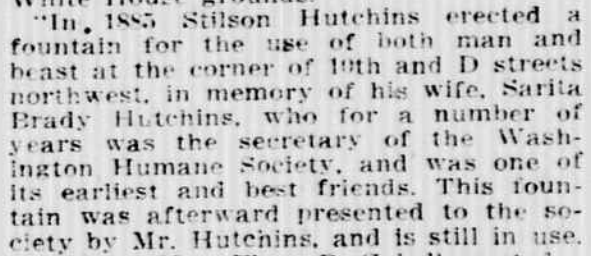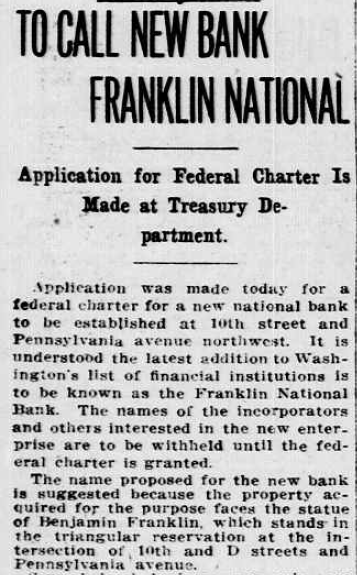DC’s Ben Franklin statue, built by the Washington Post’s founder, has a storied past

Image by the author.
A statue of Benjamin Franklin stands on the southeast corner of 12th St. and Pennsylvania Avenue NW. A sheaf of papers in his left hand, Franklin gestures with his right as if arguing a point of policy. He faces the avenue, his back turned to the Old Post Office Building currently occupied by the Trump Hotel. Beneath him, a square 11-foot granite pedestal bears four words, one on each side: Philosopher. Printer. Philanthropist. Patriot.
But Franklin was never meant to be here. By the time the Old Post Office was completed in 1899, he had already stood for a decade at a different location.
The donor
Stilson Hutchins was a newspaper man. After starting a daily in St. Louis, Hutchins moved to Washington and promptly founded the Washington Post in 1877. Three years later, Hutchins moved the Post to a massive new purpose-built structure on the northeast corner of 10th and D Streets NW.
Hutchins’s first contribution to the streetscape outside the Post came in 1885. His wife, Sarita, had died the previous year at age 35 during childbirth, and Hutchins installed a fountain on the east side of 10th Street in her memory. Like her husband, Sarita had been a leader in the local Humane Society; accordingly, the fountain featured a built-in curbside trough for horses as well as a separate spigot on the other side for human use.
Hutchins Fountain as seen looking west across 10th Street, 1959. Image from Emil A. Press slide collection, Historical Society of Washington, DC; used with permission. 
Mindful of his standing in the city—and undoubtedly eager to one-up the rival Evening Star, headquartered one short block to the west at 11th and Pennsylvania—Hutchins continued making highly visible improvements to the public areas adjacent to the Post building. Next, he contrived to donate a statue of Benjamin Franklin to the District. His proposed site: a small triangular federal reservation just outside the Post at the intersection of 10th, D, and Pennsylvania.
The artists
German-born sculptor Ernst Plassman furnished the design, closely modeling the figure on the earlier Franklin statues he had created to stand in New York City in Printing House Square/Park Row (1872) and on the headquarters of the Staats-Zeitung German-language newspaper (1873).
However, execution of the statue planned for Washington fell to another artist, Jacques Jouvenal. Born in Germany like Plassman, Jouvenal was the descendant of Huguenot Protestants who fled religious persecution in France. After emigrating to the United States in 1853, Jouvenal came to the District of Columbia in 1855 and began work on the capitals of columns for the Capitol building. His son Rudolph, trained in sculpture and stonecutting by his father, was later given the honor of cutting the obelisk capstone for the Washington Monument.
Perhaps not coincidentally, Jouvenal operated a successful statuary and memorial workshop at 941 D Street NW until Hutchins constructed his new Post building on the site in 1880. (The 1881 city directory shows Jouvenal relocating his workshop to a new site at 11th and New York Avenue.)
Jouvenal’s workshop, 941 D Street NW ca. 1875. Image from General Photograph Collection, Historical Society of Washington, DC; used with permission. 
Boyd’s District of Columbia Directory, 1880; note accompanying listings for Jouvenal’s sons Adolph and Rudolph. 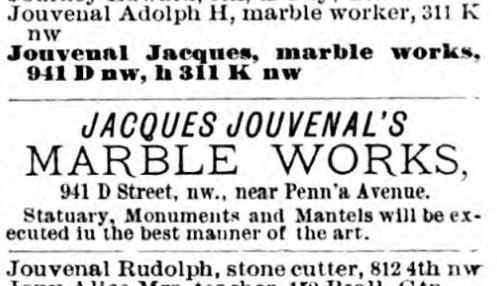
After nearly five years (and an act of Congress), Jouvenal’s 8½-foot work—cut from a solid block of Carrara marble—received its official unveiling on January 17, 1889. Unsurprisingly, Hutchins’s own paper printed a favorable review, noting for good measure that “[t]he statue was uncovered without ostentation or parade, Mr. Hutchins having declined a great many suggestions to make what he styles a ‘fuss’ over it.”
The site
Initially, Franklin’s statue stood on a small circular traffic island:
View west along Pennsylvania Avenue from 10th St, ca. 1890. Image by Library of Congress stereograph.
When the Post moved in 1893 to yet another custom building (1339 E St. NW), Ben remained in place, looking out over the Pennsylvania Avenue commercial bustle that barely slowed even for holiday parades:
Labor Day parade on Pennsylvania Avenue, ca. 1894. Franklin statue visible in bottom left corner; at center, new Post Office Building under construction. Image by Library of Congress.
By 1909, the District had constructed a large triangular plaza around Franklin to direct traffic in a more orderly pattern:
Public significance as a local landmark
Over the years, civic, religious, and political organizations used the Franklin statue plaza for a variety of public events. The Salvation Army held regular meetings there to play music and proselytize; in 1915, suffragist “pilgrims” gathered there after a month-long trip through Maryland in a covered wagon; and in 1920, the site hosted a rally for world disarmament.
January 17—the anniversary of Franklin’s birth—became a popular occasion for wreath-laying ceremonies by professional typesetters and alumni of the University of Pennsylvania (which Franklin founded), among others.
D.A.R. wreath ceremony, Jan. 17, 1924. Image by Library of Congress.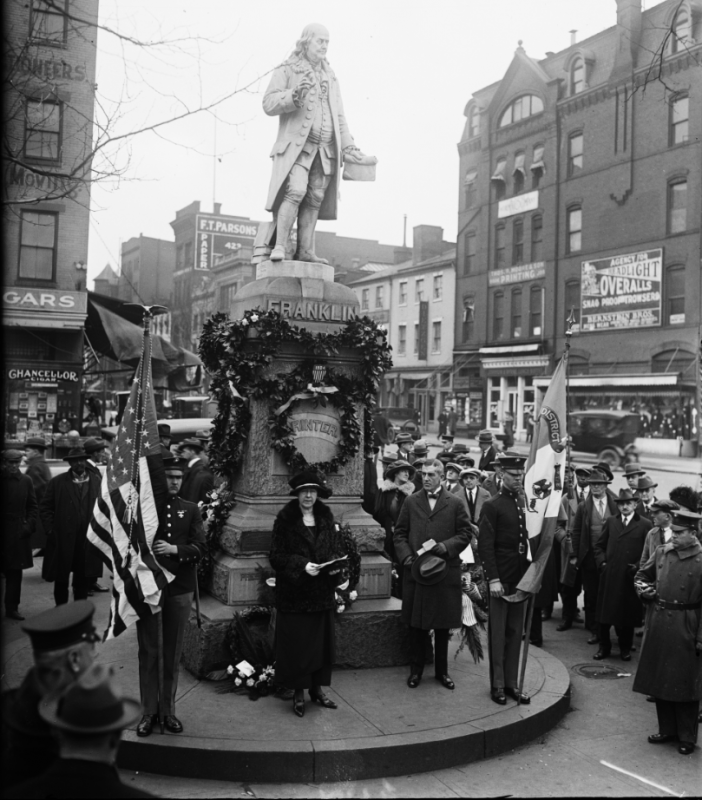
In 1914, investors acquired the existing bank building across 10th St. (on the sliver block bounded by D St. to the north and Pennsylvania on the south). Obtaining a new charter for their own bank, they named it the Franklin National Bank because of its proximity to the statue.
Franklin National Bank, 1924; statue partially visible at bottom right. Image by Library of Congress.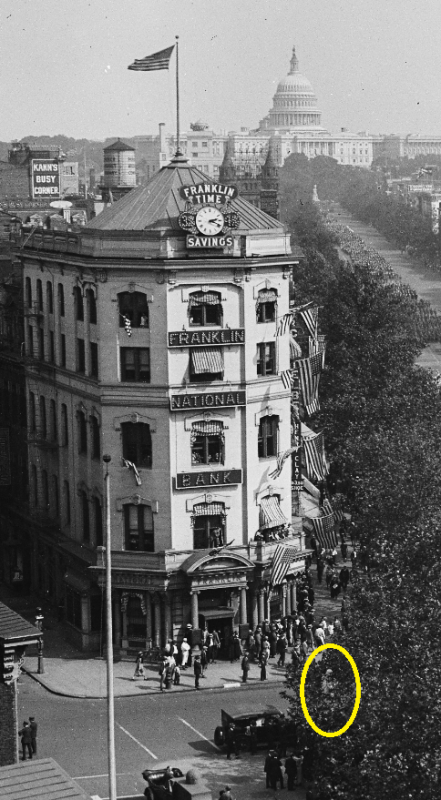
Starting in 1921, bank officials jumped onto the January 17 wreath-laying bandwagon to drum up publicity for their annual “Thrift Week.”
Washington Times, Jan. 17, 1921. 
In 1921, and again in 1929, controversy arose over the fact that the statue needed cleaning. The difficulty was that all other memorials in the District were federally owned and managed; the District’s local government (headed by three federally appointed commissioners) had no funding or personnel dedicated for such tasks.
Pennsylvania Avenue’s decline and transformation
By the mid-1960s, Pennsylvania Avenue stood at the brink of massive change. Spurred by President Kennedy’s concerns about urban blight along the capital’s signature boulevard, the executive branch conducted numerous studies of the avenue—and struggled to find a plan for preservation and redevelopment acceptable to Congress.
In 1965, the old Post building—and everything else on the blocks from 9th to 10th and E to Pennsylvania—was razed to clear the way for construction of the new FBI headquarters. Further change came when District officials began to do away with the city’s few remaining horse troughs. Sanitation officials removed the Hutchins fountain in late 1966, as reported by the Star two months later:
Shortly after its creation in 1973, the Pennsylvania Avenue Development Corporation (PADC) turned its gaze on the Franklin statue as part of its sweeping reorganization of the streetscape. Within a year, PADC had decided to close the short section of D Street west of 10th, widen the sidewalk into a broad plaza, and relocate Franklin’s statue.
PADC’s selection of the new location—in front of the Old Post Office—was unusual. Not long after Congress established the Commission of Fine Arts as part of the McMillan Plan’s implementation, the CFA considered and rejected an identical proposal:
Report of the Commission of Fine Arts, June 1917. 
PADC’s stated justification for moving the statue turned not on esthetic grounds, but instead on Franklin’s role as the first U.S. Postmaster General. The final move took place in 1980. (Numerous sources, including NPS, claim incorrectly that PADC relocated the statue in 1982.)
Washington Post, Dec. 17, 1980. 
Franklin today
No matter how Franklin ended up where he now stands, it’s worth recalling the principles he extolled and embodied: hard work, scientific inquiry, fiscal prudence, thoughtful international diplomacy, and religious tolerance. It is equally worth noting the personal stories of the people who sponsored and created his statue.
Collectively, they represent the central role of the free press; the significant contributions of America’s immigrants and their descendants; philanthropy; and patriotism. Those values are ones every District inhabitant would do well to remember.
Special thanks to the Historical Society of Washington, DC for making photos from their collections available for inclusion.

